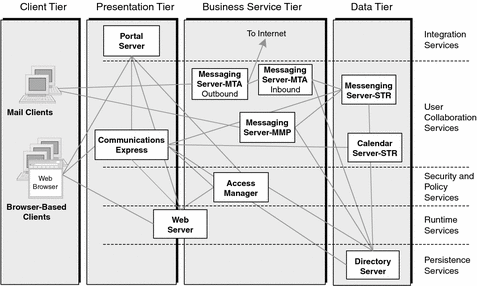Example Java Enterprise System Solution Architecture
Java Enterprise System supports a broad range of software solutions.
Many solutions can be designed and deployed out-of-the-box, with no development effort, by using components included in Java Enterprise System. Other solutions, might require extensive development efforts, requiring you to develop custom J2EE components that provide new business or presentation services. You might encapsulate these custom components as web services that conform to Simple Object Access Protocol (SOAP) interface standards. Many solutions involve a combination of these two approaches.
This section provides an example that demonstrate how Java Enterprise System supports an out-of-the-box solution, drawing from the architectural concepts of the previous section.
Enterprise Communications Scenario
Businesses commonly need to support communication among their employees, specifically email and calendar services. Such businesses find it advantageous for their employees to have personalized access to internal web sites and other resources based on enterprise-wide authentication and authorization services. In addition, these businesses want employee identity to be tracked across all enterprise services, so that a single web sign-on provides access to all such services.
These specific business requirements, which represent only an example set of business requirements, are summarized in the following table.
Table 2–4 Business Requirements Summary: Communications Scenario|
Business Requirement |
Description |
Java ES Services Needed |
|---|---|---|
|
Single sign-on |
Access to secure enterprise resources and services based on a single identity with single sign-on for web access. |
Identity services |
|
Messaging Calendar |
Email messaging between employees and with outside world. Electronic employee calendaring and meeting arrangements. |
Communication and Collaboration services |
|
Portal access |
Single, web-based, personalized access point to communication services such as email and calendar as well as internal web pages. |
Portal services |
In addition, an enterprise has requirements concerning the performance, availability, network security, and scalability of the software system that provides these services.
Logical Architecture for Example Scenario
A logical architecture for delivering the portal, communication, and identity services identified in Table 2–4 using Java ES components is shown in the following figure. The architecture treats logically distinct configurations of Messaging Server as separate components because of the distinct services they each provide.
Figure 2–7 Logical Architecture for Enterprise Communications Scenario

The components are placed within a horizontal dimension that represents standard logical tiers and within a vertical dimension that represents infrastructure service levels. The interactions between the components depend on their functions as distributed infrastructure services (interactions between infrastructure service levels) or their roles within a tiered application architecture (interactions within and between logical tiers).
In this architecture, Access Manager, accessing user information stored in Directory Server, is the arbiter of single sign-on authentication and authorization for Portal Server and other web-based components in the presentation tier. Messaging Server components include a message store (Messaging Server-STR) in the data tier, sending and retrieving components in the business services tier, and an HTTP access component and Communications Express in the presentation tier.
The logical architecture also shows the infrastructure service dependencies between the various Java ES components. Portal Server, for example, depends on Communications Express for its messaging and calendar channels and on Access Manager for authentication and authorization services. These components, in turn, depend upon Directory Server for user information and configuration data. A number of components require web container services provided by Web Server.
For more information about Java ES solution logical design, see the Sun Java Enterprise System 2005Q4 Deployment Planning Guide.
Deployment Architecture for Example Scenario
In moving from the logical architecture to a deployment architecture, quality-of-service requirements become paramount. For example, protected subnets and firewalls might be used to create a security barrier to back-end data. Availability and scalability requirements might be met for many components by deploying them on multiple computers and using load balancers to distribute requests among the replicated components.
However, where more demanding availability requirements apply and where large amounts of disk storage is involved, other availability solutions are more appropriate. For example, Sun Cluster can be used for the Messaging Server store and multimaster replication can be used for Directory Server.
For more information about Java ES solution deployment design, see the Sun Java Enterprise System 2005Q4 Deployment Planning Guide.
- © 2010, Oracle Corporation and/or its affiliates
